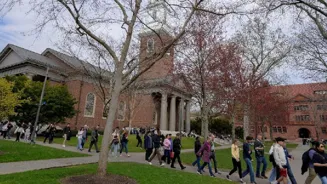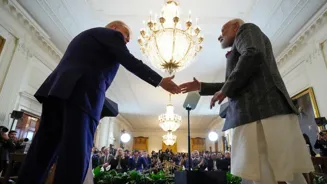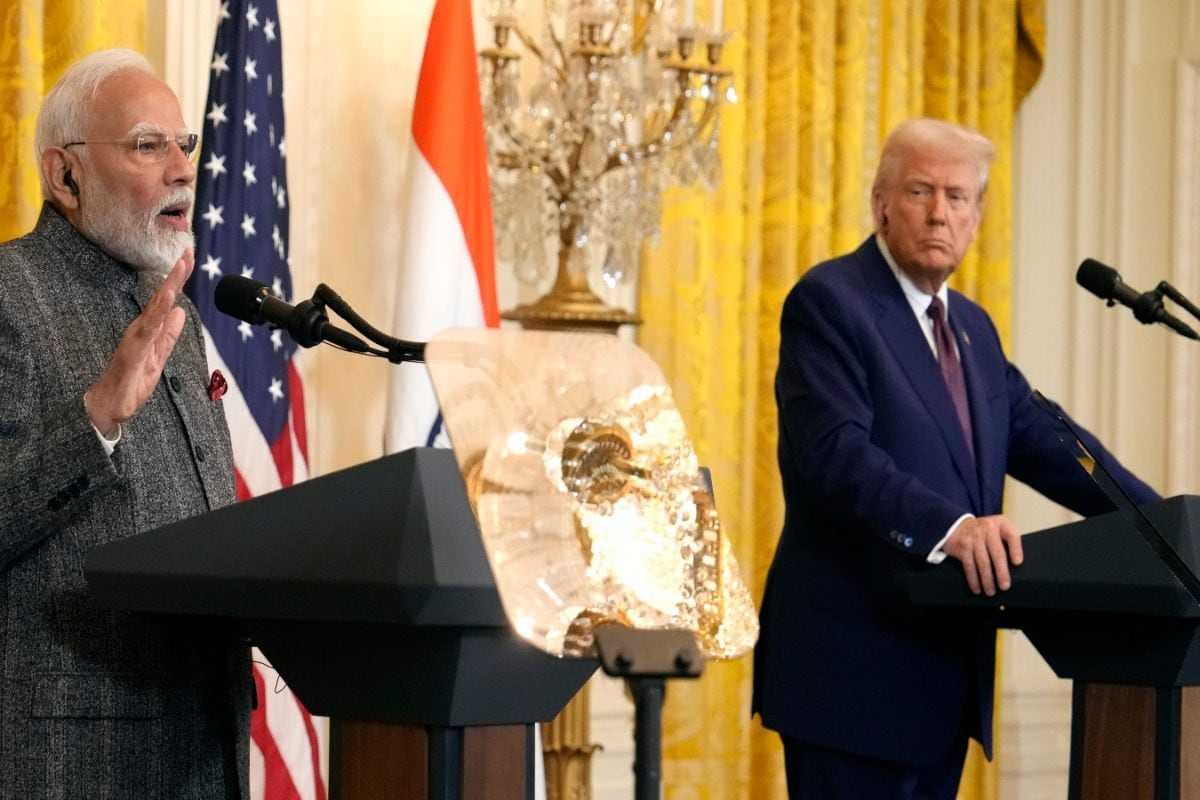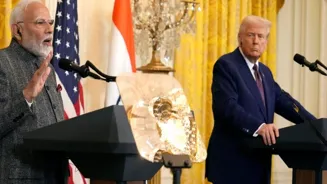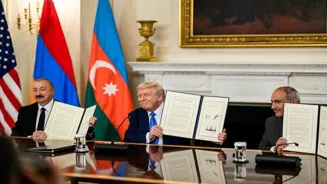The return of a hard-edged “America First” agenda in Washington has put US universities back in focus. From tighter controls on who gets a student visa to tougher scrutiny of federally funded research,
the higher-education ecosystem is feeling fresh pressure.
For Indian students, the largest international cohort in the US, the stakes are immediate: admissions choices, funding odds, internship pathways, and post-study work options all hinge on what changes in Washington actually stick.
Let’s dive deep to understand the pressures, how universities are responding, and what Indian applicants and families should plan for in the 2025-26 cycle and beyond.
What’s Changing On Campus?
Federal research money under sharper scrutiny
Universities depend heavily on the National Science Foundation (NSF), National Institutes of Health (NIH), the Department of Energy (DOE) and the Pentagon for research funding. The current policy environment stresses “research security,” disclosure of foreign ties, and limits on collaborations with entities tied to strategic rivals. That does not mean labs go dark, but it does mean more paperwork, slower grant flows, narrower partner lists, and—crucially—fewer fully funded RA lines in sensitive fields.
Departments in AI, advanced semiconductors, quantum, aerospace, and biosecurity feel this first. Humanities and social sciences face a different squeeze: DEI (diversity, equity, inclusion) budgets and certain outreach grants are political targets in several states; when those are trimmed, related grad assistantships and student services shrink too.
Compliance overhead eats into faculty time
New disclosure rules and export-control checks push PIs (principal investigators) to spend more hours on compliance. That translates into fewer paid research hours for students, especially international Research Assistants who rely on faculty grants. In tight labs, that can reduce the number of funded admits a department can responsibly take in any one cohort.
Campus speech and protest rules harden
Universities are recalibrating codes of conduct and event policies. For most Indian students, this does not directly affect immigration status, but it shapes campus climate and the kinds of activities students can safely engage in. A more regulated protest environment can also influence how comfortable international students feel participating in public discourse.
What Is The Status Of Visas?
F-1 student visas
The baseline F-1 process remains intact: admission → I-20 → SEVIS fee → consular interview. The near-term risks are consular backlogs (if staffing is tightened), more probing interviews on funding and ties to India, and stricter documentary checks for programmes in sensitive STEM fields. None of this is new; the difference is consistency and volume—how often consulates apply the toughest reading of the rulebook.
OPT and STEM OPT
Optional Practical Training (OPT) (12 months) and STEM OPT extensions (additional 24 months) have been critical bridges from study to work. Policymakers sceptical of foreign labour sometimes frame OPT as a “backdoor work visa.” If rules tighten—say, narrower employer eligibility, more audits of training plans, or stricter unemployment-day counting—the internship-to-H-1B pipeline could narrow, especially in smaller firms that lack HR compliance muscle. Expect bigger employers to adapt faster than start-ups.
H-1B and the long game
Even without new laws, enforcement and adjudication standards can swing approval rates. More Requests for Evidence (RFEs), stricter interpretations of “specialty occupation,” or higher wage-level expectations can raise the bar. For Indian STEM graduates counting on the OPT → H-1B → green card runway, this is the pinch point. Master’s students still have the master’s cap advantage in the H-1B lottery, but odds and processing rigor matter.
Security reviews
Students and scholars working in AI, advanced computing, aviation, materials, or biosciences may face extra screening. The goal is to prevent leakage of dual-use technology. Practically, this can delay visas or push some departments to guideline-restrict international student involvement in certain sub-projects.
What Funding Cuts Look Like On The Ground?
“Funding cuts” rarely arrive as a headline that says “50% less for students.” Instead, they show up as:
- Fewer RA/TA offers in the first admit round; more “self-funded” admits.
- One-year TA guarantees instead of two, pending “availability of funds.”
Frozen new faculty hires, shrinking the number of labs able to onboard funded graduate students.
Departmental travel and conference budgets trimmed, limiting student exposure and networking.
Internal fellowships narrowed to citizenship-eligible pools (where source of funds requires it).
Public universities are more sensitive to state politics; private universities move more slowly but must balance endowment payouts against market volatility and donor preferences. In both cases, the competition for fully funded PhD seats tightens first, then selective master’s programmes may lean more heavily on tuition-dependent cohorts.
How Universities Adjust To Admissions
Yield protection & waitlists: Schools may protect yield by leaning on waitlists until they see spring visa patterns and funding confirmations.
Programme mix: Expect growth in professional master’s programmes with strong industry links (data, cyber-security, analytics, supply chain), where employability offsets funding constraints.
Industry co-ops: More programmes will formalise co-op or embedded internship models to reassure students (and consular officers) about practical training.
What It Means for Indian Students?
For Undergraduates:
Costs: Need-based aid for internationals remains limited outside the top privates. Any federal tightening will not directly cut your aid (you don’t get US federal aid), but university budget caution can reduce institutional scholarships.
Strategy: Apply to a spread of schools, flagship public, mid-tier privates, and a couple of financial-aid-friendly elites. Demonstrate ability to fund four years in your documents.
For Master’s
Funding reality: Assume tuition-funded unless a programme explicitly advertises assistantships. Budget for year one fully; look for on-campus roles and merit scholarships for year two.
OPT focus: Choose programmes with strong employer pipelines, robust career services, and STEM designation if relevant.
For PhD / Research master’s
Lab-first approach: Don’t just apply to a university; court the PI. Ask specific questions about grant timelines, RA availability, and project scope. A supportive PI with multi-year funding beats a generic admit every time.
Plan B: Apply across countries (Canada, EU, Australia) for similar labs. Funding risk is idiosyncratic; diversify.
Practical Checklist: Minimising Risk, Maximising Outcomes
Document depth
Show liquid funds, lawful sources, and realistic cost coverage. Tie your study to a credible India-focused career plan to strengthen visa narratives.
Pick resilient programmes
Prioritize departments with industry-embedded curricula, co-ops, or long-running employer relationships. For research, scan recent grant awards and lab publication cadence.
Timeline discipline
Book visa slots early, keep back-ups (multiple consulates if permissible), and maintain complete files (I-20, SEVIS, fee receipts, bank letters, affidavits, property ties).
Know your employment rules
CPT/OPT/ STEM OPT rules are technical. Missteps (unpaid unauthorized work, excess unemployment days) can derail status. Use the International Students Office; keep emails and approvals on file.
Scholarship mix
Leverage Indian options—education loans, state/central scholarships, and private foundations. Some Indian corporates co-fund STEM master’s with return-service clauses.
Stay inside compliance lines
Avoid research areas that your PI flags as export-controlled unless your role is cleared. Don’t freelance on projects that “seem fine.” When unsure, ask.
Will US Universities Close Doors? Unlikely—But They’ll Be Choosier
American universities still want top global talent; Indian students bring strong maths, engineering, and Computer Science (CS) skills, and a proven record of academic success. But in a stricter policy climate, institutions optimize for lower risk:
- Clearer funding proof at admission.
- Preference for candidates with internship-ready profiles (projects, GitHub, published work).
- Extra care in fields where research security scrutiny is highest.
- Think of it as a thicker filter, not a shut gate.
What Are The Three Scenarios To Watch?
Status quo plus enforcement: Rules don’t massively change, but compliance tightens. Expect more document checks, slightly stricter OPT audits, and a modest chill in sensitive STEM labs. Most Indian students adapt and thrive.
Targeted policy shifts: Narrowing STEM OPT employer criteria, higher wage expectations for H-1B, or expanded disclosure rules for researchers. Impact: harder for small firms to hire; bigger firms gain relative advantage.
Legislative gridlock: Congress remains divided; sweeping new immigration laws stall. Universities lean on private funding, philanthropy, and professional master’s growth to cushion federal uncertainty.
What Indian Families Should Do: A Checklist?
You can still study, and succeed, in the US. The pathway is there, but the margin for error is smaller.
Front-load due diligence. Choose programmes with proven funding or industry outcomes; verify before you commit deposits.
Treat immigration compliance as part of your degree. It is not an afterthought; it is a core competency.
Build a two-country fallback. Keep one high-quality non-US admit alive until your visa is stamped and you have landed.
Trump-era interventions change the friction in the system, not the fundamental value of a US degree. For well-prepared Indian students, especially those in high-demand STEM and data-centric fields, the American campus remains a powerful launchpad. The winners will be the applicants who pair ambition with paperwork precision, smart programme selection, and a realistic, multi-path plan for study-to-work transition.
